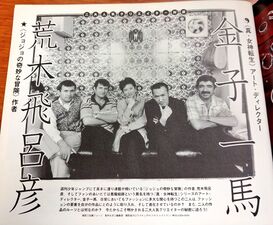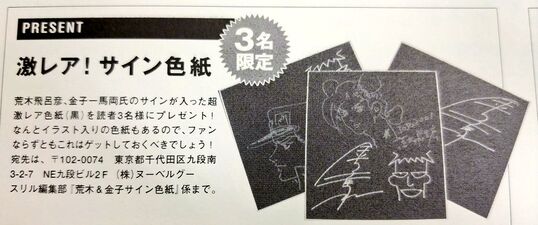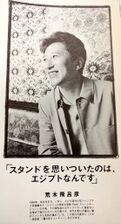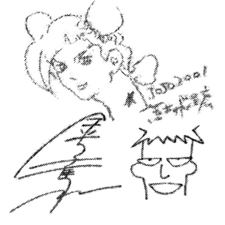THRILL (September 2001)
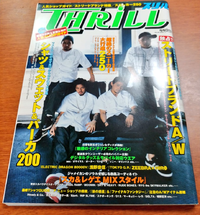
An interview with Hirohiko Araki and Kazuma Kaneko found in the September 2001 issue of the THRILL magazine (Vol. 22).
Interview
About each other’s beginnings
Araki: Shall we begin by talking about each other’s beginnings?
Kaneko: Yes.
Araki: The first question will be related to work: are you also involved in storywriting?
Kaneko: Officially not, but I contribute as well.
Araki: Ah, I knew it! Looking at the illustration books, I believe that you can’t simply draw without being involved in the story. Nevertheless, even though you only do the designs, it’s amazing how many you create. There are also a lot of descriptions about the characters’ backgrounds and so on, aren’t there? I design Stands combining those characteristics. For example, it would be strange if I didn’t give a water Stand a certain type of design.
Kaneko: Of course, I think about the way the characters are and I draw them according to their personality type.
Araki: I see. For example, if something releases poisonous gas from its shoulders, it will definitely need a hole. Now the question is, what kind of hole would fit the best?
Kaneko: But when JoJo is in front of the Stand, there will also be strange poses and things like that, right? How does that work?
Araki: I’ll eventually get to that too. Just in a little while (laughs).
Kaneko: Oh, is it still your turn?
Araki: Yes, yes (laughs). I have things I want to ask.
Kaneko: Understood. Then please ask me (laughs).
Araki: First, my parents used to read to me all kinds of books when I was a wee little boy, like “The Adventures of Tom Sawyer” or Jules Verne’s “Twenty Thousand Leagues Under the Sea”. This kind of books only and no Japanese ones at all. That’s why I grew up very attracted to foreign countries, including their food and music. And that’s also why I don’t really like Japanese food.
Kaneko: I’m not too fond of Japanese food either, but you see, my parents owned a sushi shop (laughs).
Araki: Hahaha. Really?
Kaneko: I really came to hate it when I saw eels getting skewered after their eyes were removed (laughs). Anyway, back to the main question, I was more into Disney than Jules Verne. What about music? I can see from reading your works that you love Western music. I love it as well, but you know Takenoko-zoku* right? I used to do that before.
Araki: That’s not Western music, is it (laughs).
Kaneko: But what about Dschinghis Khan? (laughs). They were very interesting. I stopped watching Yoru Hit, and quickly got into Western music and came to love funk and other styles.
Araki: I like progressive rock.
Kaneko: Eh, progressive rock? (laughs)
Araki: From the ‘70s. Bands like Yes or Emerson, Lake & Palmer.
Kaneko: Almost all your Stand names come from progressive rock bands, huh.
Araki: Well, yes but…(laughs)
Kaneko: I liked Esidisi [AC/DC] (laughs). It fit really well.
Araki: Using foreign bands’ names is ok, but it’s completely different for Japanese bands. That’s no good. Or maybe I should say, it’s empathy. It’s a bit strange, like “What kind of silly things is this guy talking about?” (laughs)
Kaneko: Well, Western bands also sing about rather silly things, right?
Araki: If I knew what they were saying, I’d get too embarrassed to continue listening (laughs). That’s why for me it’s all about the rhythm, the propagation of sound. There’s a sort of space between the sounds. Like the subtlety of the strings, the pauses, the way the air vibrates. That’s why I’m fine with whatever they sing.
Kaneko: Do you get motivated to work during times like this?
Araki: Yes, yes, I get motivated and I start crying.
Kaneko: Wait, you start crying? (laughs)
Araki: That’s right. “Oh, this is so sad~” (laughs). Don’t you get sad even if the lyrics have nothing to do with it?
Kaneko: Oh, I do, I do. Similarly to diabolus in musica, making your emotions fluctuate, right? If you used it well, you’d even be able to manipulate people, don’t you think? (laughs)
Where do you collect data from?
Araki: Do you travel abroad to collect data?
Kaneko: No, not really.
Araki: Soo, you are the type to admire foreign countries from afar?
Kaneko: Well, I guess so. I read the books I have with utmost attention and absorb all the information the writers provide, but that’s pretty sly, isn’t it (laughs). I’d love to travel if I had the time though. You travel a lot, don’t you?
Araki: I only travel to certain places; I’ve been to Italy many times, for example, and I love how it’s the “real deal”. Other countries just look like imitations in comparison – when I see sculptures or other works of art, I can only think “Oh, this is an imitation of that one sculpture.”.
Kaneko: I want to look more into Japan’s underground, like the lifestyle of the people around Shinokubo or drug routes.
Araki: So you can include them in games?
Kaneko: Exactly. There are a lot of games that take place in our current times, so I inevitably got interested in current Tokyo. It’s not limited to the city, but the places where people gather look different depending on the time of the day; it makes me want to convey the impact of the contrast between noon and the darkness night brings. I simply like clubs and the like as well…
Araki: What kind of clubs do you visit?
Kaneko: I don’t really, but now I go to a lot of spacious establishments. When I was young, I used to go to hobby shops quite a lot, but now… Before, there was no automatic water in clubs, so the toilets would be filled with ice and once it melted it would turn into automatic water. And then, if you went to the toilet at 4 a.m., you’d find the whole place drenched in blood.
Araki: Huh, why?
Kaneko: Group scuffles, it seems. Well, both scary and painful things used to happen, but looking and hearing about those rowdy times has become very important to me now.
Araki: It’s all right if Tokyo is the main setting. I first came up with the concept of “Stands” when I was in Egypt, since the people over there looked really suspicious. So I thought they were all bad guys.
Kaneko: Hahahaha.
Araki: It wouldn’t have been odd if anyone there had turned against me. No matter how kind they were to me, I just couldn’t trust them.
Kaneko: Sounds like something you won’t be able to let go of.
Araki: And that’s how I created Stands, the power of evil, or should I say, a different kind of power.
Kaneko: Ooh, is that why the manga takes place in Egypt?!
Araki: Exactly. Well, the editor loved Egypt as well; the locals’ power was truly great.
Kaneko: As I thought, you need to be there to actually know what it’s like.
Araki: That’s why people close by have great power, but the further they are, the weaker their power gets. I made all kinds of rules.
Kaneko: It would be boring if they were all-powerful. It’s good that the characters in your manga also have weak points they can overcome. We use demons in our games, but we thought of adding a slightly different nuance to it – “What if we used them as guardian spirits?”. That’s how the concept of Persona was born. We call them guardian spirits, but they are actually great Indian gods or all other kinds of demons. Just as the name suggests, doesn’t Persona mean someone’s “personality”? One’s other self. So, how should I put it, there are all kinds of “other selves”, from the characters’ current appearance, to their manner of speech and even their job. I thought I’d combine them all. That’s how the characters in the game became more natural. The impetus to start drawing
Araki: What made you become a graphic designer?
Kaneko: I’d been drawing for a long time, but I wanted to become a manga artist at first. Later, in middle school, when I wanted to be popular with girls, I tried to look like a badass, but failed (laughs). When I reached a certain age, I asked myself what job I’d take; I couldn’t become a musician, I couldn’t become anything. And the last option I had was drawing. Getting into a company was a good idea, but I realized I didn’t have much strength by myself, so after that I decided to do my best.
Araki: You see, I went to the kendo club in school, but I wasn’t praised even once, whether I won or lost. However, when drew manga, everyone would tell me how good I was. Those were my beginnings. My friends would get really enthusiastic about it, like “This is the greatest thing ever!”
Kaneko: Hahaha. It looks like you already had editors by that time.
Araki: Yes, yes, they really sounded like editors (laughs). So I really got into this and would tell myself I’d keep drawing the entire following night as well. These designs [are influenced] by Go Nagai, right?
Kaneko: That’s right, Go Nagai’s influence is strong. Also, Kamen Rider, kaiju…
Araki: Yes, the kaiju effect is definitely there!
Kaneko: It’s impossible to say the name of every kaiju, but if someone shows me Rider cards, I can tell everyone’s names. You know what’s interesting though? When you look into the designs and discover the original source of inspiration, like Ultra Seven’s monsters being the spitting image of clay figures (dogu).
Araki: Ah, yes, you’re right.
Kaneko: I realised this when I was wondering whether armor should have a (Western) clothes motif, but then saw that if you left out the armor it would have looked just like Ultraman’s costume; the outline makes it look like Western armor.
Araki: An extremely abstract image. Didn’t Picasso, after seeing African masks, want to see how simple he could make his own paintings? Same here. Ultraman’s form is indeed extreme. The type of design you simply can’t imitate, just like Snoopy. You generally can’t draw that sort of thing.
Kaneko: You start thinking why it is actually like that (laughs).
Araki: If you make Ultraman’s design simpler than this, he won’t look cool anymore.
Kaneko: Besides, anyone will be able to draw him. That’s why adding one thing after another is easy. Simplifying things, on the other hand, is really difficult.
Finally talking about fashion
Kaneko: What do you usually wear? Neatly fitted clothes?
Araki: I rarely wear ties and the like. And even then, I don’t even know whether there is a brand that actually suits me. There are brands that don’t fit me at all, that make me feel like I’m anything but myself. Prada, for example, or Gucci.
Kaneko: This does tend to happen indeed. I have a lot of Gaultier suits, but I do go shopping often too, so when I’m asked “So, manga artists are coming?”, it seems they are pretty familiar with Jump authors like K.M. or T.B. Apparently, Mr. K.M once spent several tens of thousands of yen on clothes. “That’s so awesome!”, I thought. It looks like Mr. T.B’s goes shopping together with his friends or his girlfriend though. In the end I realised that there are all kinds of manga artists as well! (laughs)
Araki: I don’t really go shopping. My brand picks are Versace or Dolce & Gabbana, but I’m not too crazy about them. I love looking at models though. Don’t you think models have this kind of spectre quality to them? The way they tilt their head or their mouths look oddly big. That kind of stuff captivates me. And so, by reproducing them, they gradually turn into Jojo-like characters (laughs) – like bending their hips back or forth. This kind of bending is also because of Italy.
Kaneko: So this is how they turn into Jojo poses! Like, “Zukyuuun!!” or grabbing a blood vessel and going “It's so thick!” (laughs). There’s a fairy named Trish in Persona who helps characters recover their health whose name comes from the fashion model Trish Goff. Back when she wasn’t that famous, I used to think she was very cute and had such an interesting name. But then she became super famous not long after and I thought “Oh no, this isn’t good!” (laughs).
Araki: I find it amazing that you knew about her since back then. She was already popular by the time I had created Trish Una.
Kaneko: All models have really cool names, don’t they? Like Shalom Harlow.
Araki: Her huge eyes are cool as well.
Kaneko: Lately, thin models have become more numerous than bigger ones, huh. Like Devon Aoki.
Araki: Devon Aoki has got a strange air about her too.
Kaneko: Did you know she is Rocky Aoki’s daughter?
Araki: Eh, is that so? Who is Rocky Aoki anyway (laughs).
Kaneko: Do you know the restaurants Benihana?
Araki: Oh, yes, yes.
Kaneko: He is the owner. Incidentally, isn’t there someone in Jojo part 4 who likes Ferré*? I wondered if you liked him.
Araki: Truth is, I write about such things even if I’m sure almost no one knows about them anyway.
Kaneko: Moschino is the same, right?
Araki: Oh, oh, Moschino was good too! I was surprised when it appeared. The peace sign* design came from there.
Kaneko: Double suits are characteristic of them too. The buttons are in the place of the eyes, forming a face. I’ve seen new designs from John Galliano or Alexander McQueen as well. They’d make good Stands (laughs).
Araki: I like Roberto Cavalli too. Quite a lot of people have been debuting these days, but don’t have shops in Tokyo. They remind of the style worn by dangerous ladies which is really great.
What flows from the root of your work
Kaneko: Your works are referenced in a lot of things, right? It’s kind of like Shakespeare, or, how should I put it, something I haven’t seen with other Japanese drama, literature or manga.
Araki: But you know, there’s also Kajiwara Ikki’s “If you are small and want to beat someone big, then you mustn’t think of yourself as small!”…or something like this (laughs). I still find this kind of thought pattern moving, even though I read that in my fourth year of elementary school. Like, “Wow, that was so cool…!”.
Kaneko: I’m a bit startled that you’ve read Kajiwara Ikki’s works. Quite different from what I expected.
Araki: Truth is, I started with “Star of the Giants”.
Kaneko: No way?!
Araki: I think it was during my first year of elementary school…I don’t usually mention this, but “Magazine” was the first publication I talked to when I wanted to publish my first manga. Incidentally, back then Kajiwara Ikki stopped serializing in “Magazine” so I switched over to “Jump” (laughs).
Kaneko: That’s seriously unexpected (laughs).
Araki: I love foreign countries, but I also love stories where poor people rise in the world.
Kaneko: Whenever I see the photos at the back of the tankobon, it’s kind of rude of me to say, but I think you look like you had a good upbringing (laughs).
Araki: Hahahaha.
Kaneko: So when you write about Rohan Kishibe and those kind of stories, all the more I wonder “Is this really all right?” (laughs)
Araki: But you are surprising as well. You had a more frightening image.
Kaneko: I’m often told that I seem to have an actor’s personality. Truth is, I’m a pretty easy-going guy. Speaking of manga, I was into “The Genius Bakabon”.
Araki: Oh, Akatsuka Fujio (laughs). It was quite a thing (laughs). Great stuff.
Kaneko: I simply loved the surrealistic setting, couldn’t get enough of it. After all, it’s the person who discovered Tamori*! In a way, he raised him and turned him into who he is today.
Araki: Speaking of settings, I went to a Christian school, where I read the Bible every day, so that particular way of thinking got ingrained in my brain.
Kaneko: Is that so! Was it a Catholic school?
Araki: No, it was a Protestant one. As a kid, I thought “What the…?” at the disciple’s betrayal, but as an adult I understood how important it was. Different kinds of literary works also have their roots in it, and I’ve come to understand numerous other allusions. However, in my case, rather than believing in God, I believe something exists. It’s difficult to pinpoint what it is, but it also includes destiny. That is why, if my works aren’t based on something of the sort, the end result is scary and I end up asking myself why I am drawing manga in the first place. Am I doing it to earn money or to impress women? The more time passes, the more horrible this would all feel. But I can keep going as long as I have fairness and humanity.
Kaneko: Indeed, you wouldn’t be able to draw if you didn’t have human love. Getting money out of all this too is obviously fine though (laughs). But doing it just for money isn’t right.
Araki: You definitely need it in order to go on, don’t you think?
Kaneko: It also gets difficult when you start thinking why people exist.
Araki: You reach this question when you draw about things like destiny – “Why is this person here?”. If you’re attached to the protagonist, the question becomes even more important. The people who make RPGs feel that to an even higher degree, right?
Kaneko: That’s right. We think about the inevitable fate of the characters. Animals are part of the cycle of life on earth, aren’t they. Earthworms exist to clean the soil and their purpose to leave descendants. Only humans are different.
Araki: But it’s not good if that kind of world comes to the surface. There are several layers we shouldn’t see beyond and it would be even worse if they didn’t exist. This isn’t only about manga, but also about music and just about everything.
[Translated by Dijeh][1]
二大人気クリエイター対談
週刊少年ジャンプにて長きに渡り連載が続いている『ジョジョの奇妙な冒険』の作者、荒木飛呂彦。そしてファンのあいだでは悪魔絵師という異名を持つ『真・女神転生』シリーズのアート・ディレクター、金子一馬。日常においてもファッションに多大な関心を持つこの二人は、ファッションの要素を自分の作品にどのように取り入れ、そして進化させているのか? また、二人の作品のルーツとは何なのか? 今だからこそ明かされる二大人気クリエイターの秘密に迫ろう!
★お互いのルーツについて荒木 まずお互いのルーツなんかについてお話しましょうか。
金子 そうですね。
荒木 まず仕事の内容なんですけど、ストーリーまで関わっているんですか?
金子 はっきりとは公表していないんですが、僕も考えています。
荒木 あっ、やっぱり!だってグラフィック集を見ていて、ストーリーに関わっていないと描けないデザインだと思ったんです。 ただデザインしているだけで、こんなに多くのデザインができるのかと不思議だったんですよ。キャラクターとかの状況とかいろいろとあるじゃないですか。 スタンドっていうのは、その技の特徴に合わせてデザインしていくんです。 例えば水の中で活躍するスタンドであったら、こういうデザインにしなきゃおかしいみたいな。
金子 やはりキャラクターの行動原理みたいなところを考えていくと、こういうタイプのキャラクターだから、こういう格好をしている、そういうのがありますからね。 荒木 そうですよね。肩から毒ガスが吹き出すから穴がなきゃとか。それじゃあどういう穴がいいかな、みたいな。
金子 でも、スタンドの前にジョジョだったら、怪しいポーズとかほかにもいろいろとあるじゃないですか。あのへんはどうなんですか?
荒木 それはそのうち語りますよ……チョットあとで(笑)。
金子 あ、順番があるんだ?
荒木 そうそう(笑)。お聞きしたい順番があるんですよ。
金子 分かりました。じゃあ僕が聞かれちゃうんですね(笑)。
荒木 まず、自分のほうから言うと、ウチの両親がちっちゃい頃、本をいろいろと読んでくれたんですよ。 『トム・ソーヤの冒険』とか、あとジュール・ヴェルヌの『海底二万里』とか。 そういうのばっかでね、日本のじゃないんですよ。だから、なんか異常に外国へ対する憧れが強かったんですよ。で、食べ物や音楽にいたるまでそういうふうになっちゃって。だから日本食とかもあんまり好きじゃないんですよ。
金子 僕も和食あんまりなんですけど、でも寿司屋の息子なんですよね(笑)。
荒木 ハハハハ。ほんとに?
金子 それで目の前でアナゴとかの目玉にザクッ!とか串刺しているのを見て、イヤになっちゃった(笑)。 でも、本に関しては僕はジュール・ベルヌとかよりは、ディズニーっぽいほうが多かったですね。音楽はどうですか?荒木さんの作品読んでいたら分かりますが、洋楽好きそうじゃないですか。 僕も洋楽大好きなんですけど、タケノコ族とか昔流行りましたよね?僕、タケノコ族やってたんですよ。
荒木 あれ洋楽じゃないじゃん(笑)。
金子 でも、ジンギスカンとか(笑)。ああいうの聴いちゃうとおもしろいじゃないですか。そうしたら夜ヒットとか観れなくなっちゃって、そのまま洋楽にどんどん入っちゃって、ブラックとかファンク系が好きでしたね。
荒木 僕はプログレです。
金子 えっ、プログレ(笑)?
荒木 もろ’70年代ですよ。イエスとかエマーソン、レイク&パーマーとか。
金子 スタンド使いの名前はプログレばっかりじゃないですよね。
荒木 まぁ、全部ありなんですけど(笑)。
金子 僕が気になったのが”エシディシ(AC/DC)”(笑)。結構親近感ありましたよ。
荒木 バンド名は何でもオッケーですよ、外国のものであれば。日本語がダメなんですよ。拒否反応が出ちゃって。仕事中にね、感情移入しちゃうというか。ちょっとピクってきちゃう。「何こいつスカシたこと言ってんだ?」みたいな(笑)。
金子 まぁ、洋楽もかなりスカシたこと言っているんですけどね。
荒木 理解したらこっ恥ずかしくて聴けないことばっかでしょ(笑)。だから私の場合はリズムとか、音の広がりですよね。なんか空間があるんですよ、音と音の隙間の中に。なんかね、そこにグワッと入れるんですよ。ストリングスとかの微妙なところでね、待ちがあったりとか、風が吹いたりとかさ。だから、その人が何歌っていてもいいんですよ。
金子 そういうときはもう仕事がノリノリになったり?
荒木 そうそう、ノリノリになったり泣いたり。
金子 えっ、泣いちゃうんですか(笑)。
荒木 そう。「うわぁ~、切ないなぁ~」って(笑)。歌詞とか関係なく切なくなったりしません?
金子 いや、ありますあります。悪魔音階っぽいっていうんですか、なんか気持ちを上下させるものってありますよね。あれを上手く開発すれば人を操ることができるんじゃないですかね(笑)。
★取材にはどこへ行く?
荒木 よく取材で海外とかには行かれるんですか?
金子 いえ、僕はあんまり行かないです。
荒木 じゃあオタク系の外国マニアですか?
金子 まぁそうです。人が一生懸命書いた本を一生懸命読んで、その人の情報をすべていただくというズルいやり方です(笑)。でも、時間があれば行きたいですけどね。荒木さんはよく行ってますよね?
荒木 私は場所限定ですけどね。イタリアとかが多いですね。イタリアは本物っぽいところがなんか好きなんですよ。他の国はその物真似みたく見えちゃうんですよ。彫刻とかを見ていても、「あ、これはあの彫刻のイミテーションだ」とか思ってしまうんですよ。
金子 僕はどっちかと言うともっと日本のアンダーグラウンドな場所を探索したいですね。新大久保で立っている人たちの生活をもっと見てみたいし、薬物とかもどういったルートで動いているのかとか知りたいですね。
荒木 それもゲームに関係します?
金子 そうですね。ゲームの世界観として現代モノが多いので、必然的に東京の今に興味があります。都会に限ったことではないけど、人の集まる場所には昼の顔と夜の顔がありますから、昼はともかくとして夜というか”闇”の部分のリアルさを描くことで、よりインパクトのあるメッセージを発信できるのかな、と思います。単純にクラブとかが好きというのもありますけど・・・・・・。
荒木 クラブはどこらへんに行くんですか?
金子 どこということもないんですが、今は大箱が多いですね。若いときはマニアックな店にもよく行ったんですが、今はちょっと・・・・・・。昔のクラブって自動で水が流れなくて、その代わりに便器に氷が置いてあったんですよ。それが解けて水が流れる仕組みになっていて。で、朝の4時頃トイレに行くとそれがすべて血だらけになっていて。
荒木 えっ、なんで?
金子 要はケンカですよね。グループ抗争みたいな。まぁ怖い思いとか痛い思いもしたけど、ヤンチャな時期にそういうものを見たり聞いたりしたことは、今の自分にとって大事な要素になってますよね。
荒木 でも東京が舞台なら東京がいいですよね。私が”スタンド”という概念を思いついたのは、エジプトなんですよ。というのは、向こうの人達ってすごく怪しいじゃないですか、見てくれが。それで全員悪党だと思って。
金子 ウハハハハハ。
荒木 こん中の誰が敵でもおかしくないなと。で、その人間を信用できないというか、いくら親切にされても、なんか怪しいんですよ。
金子 なんか腹に持っているんじゃないかと。
荒木 それで悪の力というか、もうひとつの力というか、スタンドを思いついたんです。
金子 ああ、だからマンガは最初エジプトから始まったんですか!?
荒木 そうなんですよ。まぁ、編集担当さんがエジプト好きだったというのもあったんですが。住んでいる人達のパワーがホントすごかった。
金子 やっぱ行ってみないと分からないことありますよね。
荒木 そこから近くの人は力が強いだろうけれど、遠くにいる人は力が弱いとか。いろいろとルールを作ったんです。
金子 何でもできちゃうとつまらないんですよね。荒木さんのマンガは弱いところがいいんですよ。弱点を克服していくとか。ウチのゲームは悪魔を使役するものですから、そこでちょっと違うニュアンスというか、悪魔を守護霊として付けたらどうだろう?ってなったんです。そこからペルソナが生まれたんです。で、守護霊なんだけれど、その属性はインドの偉い神様だったり、どこそこの妖怪だったりしたわけです。ただ名前が示すとおり、ペルソナって”個性”じゃないですか。もうひとつの化身ですよね。そのキャラクターの、なんていうんですか、今の格好や、しゃべり方、やっている仕事までいろいろとあるわけですよ。そういうのをすべてそこに集約してみようと思って。そういった意味ではゲームで自然とキャラクターが動いてくれましたね。
★絵を描くようになったキッカケ
荒木 金子さんがグラフィック・デザイナーになろうとしたキッカケはなんだったんですか?
金子 昔っから絵は描いていたんですけど、最初は漫画家になりたかったんですよ。でも、中学時代に女のコにもてたいなってなってきたときに、服装とかもちょっと悪ぶってみるとか、そっちにいこうとしちゃって失敗したんです(笑)。で、ある一定の年齢になったときに仕事何をやろうかなってなって、ミュージシャンにもなれないし、なんにもなれない。そして最後に残ったのが絵だったんですよ。で、会社に入ってみたはいいですけど、自分の力がたいしたことがないなってまたまた判明して、そこから努力した感じですかね(笑)。
荒木 私はね、学校のクラブで剣道とかやっていたんですが、一回も誉めてもらったことがなくて。勝っても負けても。でも漫画描いたときはね、「上手いね!」ってみんなに言われたんですよ。だからその気になりましたね。あと友達にね、すげぇ喜ぶヤツがいたんですよ。「これ最高じゃん!」みたいな。
金子 ハハハハ。既にその頃から編集者みたいなのが側にいたんですね。
荒木 そうそう編集者みたいなのが(笑)。で、ほんとその気になってきてさ、じゃあ明日もちょっと徹夜して頑張ろうかなって。この絵柄だとやはり永井豪さんですか? 金子 そうですね、永井先生の影響は強いですね。あと仮面ライダーとか、怪獣とか・・・・・・。
荒木 あ、怪獣の影響はあるね、絶対!
金子 怪獣の名前とか全部言えるんじゃないですかね。ライダーカード見せられても、怪人の名前全部言えますからね。でもおもしろいのが、デザインしていくうえで資料とか調べていると、その元ネタが分かってくるとこですね。ウルトラセブンの怪獣とソックリの土偶を発見したりとか。
荒木 ああ、あるある。
金子 鎧をモチーフに服のデザインをしようかなって思ったときに気付いたんですけど、鎧を省略していくとウルトラマンのコスチュームになるんですよね。西洋甲冑を線だけで模様にしていったりするとなるんですよ。
荒木 究極の抽象画ですね。ピカソとかもアフリカの仮面とかを見て、どこまで簡単に描けるかと試していたそうじゃないですか。同じですよ。確かにウルトラマンの形は究極ですよ。スヌーピーとかも絶対真似できない形なんですよ。あんなの描けない、普通。
金子 どうしてああしようと思ったんだって思いますよね(笑)。
荒木 ウルトラマンもこれ以上簡単にしてカッコイイのはできないですよ。
金子 それに誰にでも描けますからね。だからあとからあとから増やしていくのは簡単なんですよ。でも削ぎ落としていく作業はホント難しい。
★いよいよファッションについて
金子 普段はどういう格好をしているんですか?もっとキチッとしているんですか?
荒木 めったにネクタイとかする格好はしないですよね。でも、なんか自分にしっくりくるブランドとかってないですか?ブランドでも絶対に似合わないっていうのがあるんですよ。プラダとかは着ても合わないんです。自分じゃないというか。あとグッチもダメ。
金子 確かにそういうのはあるかもしれませんね。僕はゴルチエが多いんですけど、よく買いに行くんです。それで結構馴染みなんで、「マンガ家さんとか来る?」なんて聞くとジャンプ系のK・Mさんとか、T・Bさんとか来ているらしいですよ。K・Mさんなんかは一度にウン十万くらい買っていくそうで。「すげぇーな!」とか思いますよね。T・Bさんは友人とか彼女に買っていくそうですけど。「なんかマンガ家もいろいろやってるなー!」とか思いましたね(笑)。
荒木 僕は買い物自体あまり行かないですね。ブランドではベルサーチとかドルチェ&ガバーナとかですね。でもそんなにドカッといかないですけど。でも、ファッションといえば、モデルとか眺めているのが好きですね。モデルってなんか妖怪っぽいじゃないですか。首をひねっていたり、口が異様にでかかったりとか。そこらへんがクルときがあるんですよ、ビビッと。で、模写していくと次第にジョジョのキャラクターっぽくなってくる(笑)。腰をくねらせて立っていたりとかね。ねじらせるのは、もうイタリアの定番なんだけど。
金子 そういうのがジョジョとかの謎のポーズと化していくんですね。「ズキューン!」とか、血管つかんで「コリコリしてるぞぉ~!」とか(笑)。ペルソナで体力を回復してくれる妖精が登場するんですが、その妖精の名前がトリッシュっていうんですよ。名前はファッションモデルのトリッシュ・ゴフからとったんですよ。まだ彼女がそんなに有名じゃなかったときに、「あ、このコ可愛いな!」って思って。名前もおもしろいし。でも、しばらくしたら超有名になっちゃって「ヤベぇー!」とか思って(笑)。
荒木 でもその頃から彼女のことを知っていたのはスゴイですよね。私がトリッシュ・ウナを考えたときは超売れていたときだから。
金子 モデルの名前ってみんなカッコイイじゃないですか。シャローム・ハーローとか。
荒木 彼女もでっかいつり目でカッコイイですよね。
金子 最近大ぶりな人よりも細身のモデルのほうが多いですよね。デボン青木とか。
荒木 デボン青木も不思議な感じだよね。
金子 彼女、ロッキー青木の娘だって知ってました?
荒木 え、そうなんですか?誰ですか、ロッキー青木って(笑)。
金子 レストランのベニハナって知ってます?
荒木 あー、ハイハイ。
金子 あそこのオーナーなんですよ。それはそうと仗助(ジョジョの奇妙な冒険四代目主人公)あたりがフェレがどうのとかあったじゃないですか。だから荒木さん好きなのかな?って思って。
荒木 でもホントはこれ描いても分かんねーだろうなって思いながら描くんですけどね。
金子 モスキーノとかね。
荒木 ああ~、モスキーノも良かったね!あれが出たときはびっくりしたよ。ピース・マークのデザインとかになるんだよね。
金子 ダブルのスーツとかもスゴク特徴的で。ボタンが目の代わりになっていたりして、顔になっちゃうんですよね。最近のデザイナーではジョン・ガリアーノとか。アレキサンダー・マックイーンとか。スタンド使いにもいるけど(笑)。
荒木 あと僕はロベルト・カバーニですよね。いるんですよ、最近出てきた人が。東京にはお店がないんですけど。危な系のお姉さんの格好なんですよ。ああいうのは「いいなぁ!」とか思いますね。
★作品の根底に流れるもの
金子 荒木さんの作品って、ものごとを例えて言うじゃないですか。それってなんかシェイクスピアっぽいというか、日本の文学やドラマ、マンガにもあまりないですよね。 荒木 でもね、梶原一騎さんとかがやっているんですよ。「小さい人間が大きい人間を投げるには、自分はチビだと思わなければいけない!」みたいな(笑)。そういう概念にクッと感動するんですよ。「うまいこと言うなぁ!」って。読んでいたのは小学校4年生くらいなのに、なんか感じるものがあったんですよ。
金子 僕は荒木さんが梶原一騎を読んでいたこと自体ドキッとしましたよ(笑)。なんかかなりイメージと違いますよね。
荒木 じつは『巨人の星』から入っているんです。
金子 ウソ、マジっすか!?
荒木 小学校1年くらいだと思うんですが、その頃から・・・・・・。これはあまり言っていないことなんだけれど、最初マンガを持ち込もうとしたのは『マガジン』だったの。でも、たまたまそのときに梶原一騎が『マガジン』で連載してなくて、じゃあ『ジャンプ』のほうがいいやって(笑)。
金子 えっ、スッゲェ意外(笑)。
荒木 外国好きっていうわりには、貧乏人がのしあがっていく話も好きなんですよ。
金子 単行本に出ている写真とか見させてもらうと、こう言っちゃあ失礼ですけど、なんか育ち良さそうだなって思うんです(笑)。
荒木 ハハハハ。
金子 それでまた、岸辺露伴の話なんか書いてしまうもんだから、なおさら「大丈夫なのかな?」なんて思われちゃっているかもしれませんよ(笑)。
荒木 でも、金子さんもなんか意外ですよ。もっと怖そうなイメージがありましたから。
金子 よくそう言われるんですけどね。性格俳優ぽいって。ホントは気さくなやつなんですよ、こう見えて。僕はマンガといえば『天才バカボン』ですね。
荒木 あ、赤塚先生(笑)。それもそれで何かあれですね~(笑)。スゴイですよね。
金子 なんかあの、シュールな世界観がたまらなく好きなんですよ。だってタモリを育てた人ですよ!ある意味タモリを飼っていたんだから、個人用として。それでプロデュースしたんですよね。
荒木 世界観といえば、私はキリスト教の学校へ行っていたんです。だから毎日聖書を読んでて、自然とそういう考え方っていうのは染みついていますよね。
金子 ホントですか?カトリックですか?
荒木 いえ、プロテスタントだったんですけど。聖書で弟子が裏切る場面とか、子供の頃は「なんだろう?」とか思っていたんですが、大人になるとね、重いものがあるんですよ。いろんな文学のルーツもそこに含まれていて、いろいろとネタが分かってきて。でも、僕の場合は神様を信じているというよりも、いるって感じですね。具体的に言うことは難しいんだけど、運命とかも含めてね。それで作品の根っこのところにそういうのがないと、怖いことになるんですよ。「自分は何で漫画を描いているんだろう?」ってね。ただお金を稼ぐためなのかとか、女のコにもてたいだけなのかとかね。なんかね、それがいつかヤバイことに感じるようになってくるんですよ。でも、そこに正義だとか、人間愛だとかがあれば頑張れるっていうか。
金子 確かに人間愛とかがないと描けないですよね。お金とかがついてくるのはもちろんいいんだけど(笑)。でも、ただそれだけのためにやっているんじゃない。
荒木 やり続けるためには、そういうのが必要なんじゃないですかね。
金子 人間生きていくのはなぜ?って考え始めると、それはそれで難しいものがあるし。
荒木 こういうね、運命とかを描いていると「何でこの人ここにいるんだろう?」ってなってくるんですよ。それは主人公に思い入れがあればあるだけ強くなる。RPGなんか作っている人はもっとそういうのがあるんじゃないですかね。
金子 そうですね。キャラクターの必然性なんかについて考えてしまいますよね。動物とかって地球上に循環として存在しているじゃないですか。ミミズだって土を浄化するために生きているし、子孫を残すことが目的じゃないですか。でも人間だけは別のことをやっている。
荒木 でも、そういう世界が前面に出てくるとダメなんですよね。下の下のほうにあって、見えちゃダメなんですよ。無いともっとダメなんですけど。マンガだけじゃなくてね、音楽も何もかも。
